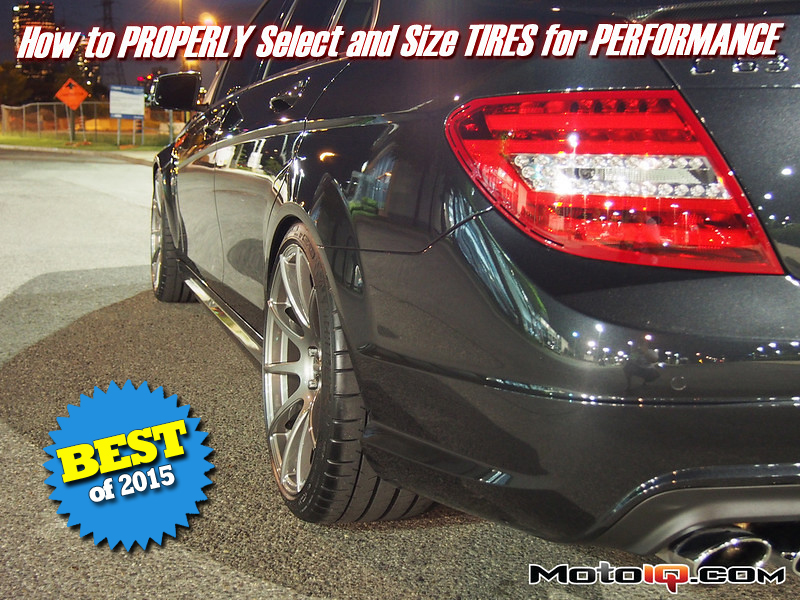STEP 4: CHOOSING A WHEEL
Wheels are an expensive investment that will affect the handling, performance, and yes, looks of your car; so it’s important to do your homework before dropping a lot of cash down. This may sound backwards but since the tire is the most important part of your car, your wheel choice should be dictated by the tires you want to run.
When I look to increase the diameter and width of a set of wheels on a car, I define the goal of the increase, whether it’s to increase tire width for cornering, or Total Tread Surface Area (diameter and width) for prolonged track capability, or even simply for looks. Based on the available room in the wheel well, I then look at the availability of the group of tires in the general size that I want to go to, which narrows down the ideal wheel size that I should run.
If you are limited by room in the wheel well or rules for a particular class, the tires should be your limiting and deciding factor. Pick the best tire in the outer diameter and section width that will fit the room or rules, and then size the wheel accordingly.
This is the opposite from what almost everyone does. Most people buy bigger wheels based on looks and offsets and then the tire tends to be a compromised afterthought to fit those wheels in the remaining room that’s available. Since this article is about optimizing the performance of a car with tires, they should dictate what size wheel to run. In many cases, the ideal tire may not be available in the size that properly fits your wheels. If handling and performance is important to you, then your wheels will be sized accordingly. If you view form > function, then this article probably isn’t for you anyway.
For a daily driver where maximizing outright grip or TTSA may not be the top priority, choosing the widest tire possible may not be necessary at any expense of steering feel, fuel economy, and price. Remember the top tip?: “A narrower high quality tire will often outperform a cheap wider tire”.
A proper amount of time should be spent on researching or measuring the wheel offsets and clearances of your current wheels to determine how much larger and wider of a tire can fit. Once the ideal tire is chosen, then you can select the diameter, width, and offset of your wheels. Staying the same or close to factory widths and offsets is a conservative way of making choosing a wheel much easier.
CONCLUSION
By now everyone should be an expert at sizing and selecting a tire, or at least possess a greater education on how tires are sized and what aspects are important when choosing a tire. By following the 3 main steps when looking for tires: CHOOSE A TIRE CATEGORY, SIZE THE TIRE, and SELECT A TIRE, it’s hard to go wrong.
Disclaimer: The information above is a recommendation for OFF ROAD USE only. Please consult and follow your owner’s manual when sizing tires for street use, otherwise follow the above advice at your own risk.
SOURCES:
If you enjoyed this article and are interested in improving yourself as a driver, check out my articles:




25 comments
Thank you, very informative article!
Loved this article. But how do you calculate or optimize vehicle weight/hp to tire size?
Amazing article. Changes my whole perception of what i am looking for. 2017 mustang gt. Drop 1 inch, tiger grip wider. Staggered or not too. Like 275 on all 4 and do I look for height and 45s height compared to 50s height for stance
Glad to hear it helped.
Nice, but what’s the optimal weight to mm for tire width? I want a good compromise for street/weekend warrior use and looks on my 09 daily driven Scion tC. Don’t wanna take too much of a hit to mpg, but I want more room to soak up hard cornering and, as I said a more aggressive look.
Stock sizes are 215/45r17 and 225/40r18. I know a 235 will fit, and I’ve seen a couple of 245 and 255 fitments online, but it’s mostly 245 or below. Currently running BFG sport comp 2 a/s tires and like them. Live in Florida and was recommended those for my application. The car is FWD with a manual and 160hp, I intend to run a square setup.
Thanks for pointing out that choosing the right tires will be able to dictate the success of the race and also keep you safe from accidents. I will share this information with a friend of mine since he will be joining races once he gets his car customized. It has really been his goal to do so after being obsessed with a series of movies that focuses on this.
This is probably the best ‘layman’ article on tires I’ve read! Here’s why I’m here. 2018 Mustang GT, stock except exhaust, air box and multiple tunes including E85. Daily driver with track weekends. Stock rims are 18 x 7.5 rolling on Pirelli P Zero Nero P235/50ZR18. I want more grip in the rear. Don’t care to change wheel diameter bc Ford Engineers are smarter than I. Contemplating going to 10″ in rear with MT ET Street SS 285/40R18. Not married to them and am open to any suggestions you may offer. I’m interested in grip and of course a better ET.
Thank you for the kind words, it’s great to hear that feedback (which was the goal). To be honest, I’m not the best source for tire sizing when it comes to drag tires since I do not have firsthand experience testing how wheel widths affect longitudinal grip and launches of drag-specific tires.
What did you end up doing? Mine is a 2017 and trying get a better stance look with a drop 1 inch with a little wider tire,but my big concern is 40 45 or 50 height tires
Thanks for listing all the details which are of importance for proper tyre selection.
t
Yet, I did miss the part explaining the influence of “aspect-ratio”.
I actually trashed a set of all-weather tyres and damaged my rim, due to driving a bit to fast on a very poor rural road. Consequently, I searched for information regarding rally tyres on the web. Interestingly, the majority of rally tires of Michelin have aspect ratios of 60-65. Yet, these tyres have very stiff side-walls. What is your opinion regarding the influence of aspect ratio?
In addition, you mentioned that you consider load-index not to be be very useful. Yet, does load index influence the strength and stiffness of the side walls? Consequently, the higher the aspect ratio, the more important load index, especially using poor roads? Appreciate your view/
Mr. Johnson, your article is the most clearly explained writing I’ve found on the matter. Still it is not very clear for me what would happen to my 2019 Toyota Camry, with original 17″ x7.5 original wheels if I change original tire size of 215/55/17 to 235/55/17. My intention is to gain half an inch in underbody clearance, and of course any gain in performance would be wellcome. I appreciate any light you can give me on this matter.
Going from a 215/55 to a 235/55 would give you a tiny bit of ground clearance but would also change the circumference of the tyre, which may throw off your odometer and other systems. I suspect it’s not a good idea, if you want more ground clearance the proper way to do it is to install adjustable coil-over suspension.
The wider tire will lose steering response and feel more vague and ‘mushy’ as the sidewall deflects more before loading up. Peak grip will likely increase. I’m not sure you’ll gain 0.5″ in ride height from making that switch. Check out a tire size calculator to be sure.
Than you for writing this article! It is very informative! What I did miss was information on what would be a balanced mm/Lb for track use. You present a table with multiple vehicles, but do not comment on whether you find those values too high or too low, with the exception of the Elise, that isn’t even on the table. What would be a good range for mm/Lb?
It depends on the tire. Whatever it takes to keep a tire in its ideal operating temperature window is what should be targeted.
First of all, excellent article, i appreciate the time and effort placed into explaining all the nuances of selecting a damn tire. Ive already screen shotted some portions for my digital “Car” notes.
I just have one critique from a data driven, engineering minded geek.
In the TTSA chart, TTSA seems to be calculated only using half of the tires….1xFront+ 1xRear… thats not total…I realize that may not be your chart, but when i come across calculations like these that aren’t completely logical, it makes me ask…why? In the end, i know it will just change those numbers by a factor by 2, but to me it makes more sense to use the TTSA that uses all four tires. Of course, if there is an industry standard that uses 1xFront and 1x Rear, then so be it; i am ignorant to it (alibi: i am new to this game)
Once again, thanks for making your experience available for the entire world to learn.
Cheers!
Haha, thanks. As far as TTSA goes, feel free to multiply all the numbers by 2. For comparisons sake, only looking at half the tires does not affect the results.
That was very helpful, thanks. On my Lotus Elise S1 (1800lbs), I’ve always found that I could not get heat into my tires (205F/245R). For many years I was following the ‘wider is better’ gang. But this year I’ve decided to try a smaller size (195 & 225). I’ll be saving weight and hopefully heat them faster too! Over the time I’ve also came up with the thinking of choosing a tire first then get the wheels. Thanks for the great article !
Glad to hear it. The #1 thing is the compound of the tire and keeping it in it’s operating temperature range.
Good article but the information I’m looking for doesn’t get addressed.
How do I choose tyre sizes for my car based on power and weight?
My car weights 550kg and has rear wheel 60bhp
I currently have 13×7″ rims wearing 195 section tyres.
I’m sure that’s too much rubber.
Should I get narrower rims and save weight or would this cause a lack of traction?
It depends on what your goals and objectives are, if you’re limited by a certain UTQG or ‘class’ of tire, and once you determine what tire you’re going to run, then you would need to look at your tire temps. If you’re overheating your 13×7″ 195 tires, then you will likely improve grip and laptimes by going with wider tires. If you are not getting your tire up to peak operating temperature, then going down on tire size will put more energy into the tire, and get the operating temps higher where the tire will make more grip. So it depends on your current setup and data.
Great article! But just want some clarification when you refer to wheel width are you referring to the width of bead seat to bead seat or the overall wheel width?
I’m so glad I found your article somewhat randomly while trying to understand which “load index” to select. You gave me a set of completely new dimensions to look for and especially to match wheel width and tire width. Spot checking shows that most 275/35R18 track focused tires i was tentatively loooking at are too wide for 9.5″ rims. Thank you!
I think your TTSA and weight ratios comparison chart is wrong. All of the numbers in the mm/lb column are half what they should be. The TTSA used is only for one tire per axle, meaning the TTSA is doubled, halving the mm/lb column.
Take the third example of the Dodge Viper, a 295/25R19 front. That’s a tire circumference of 1,980 mm x the 295 width, I get 584,100 but I don’t know the actual tread width, so close enough for this to your 587,451. That however is one tire, for both front we must double it to 1,174,902 for the front total.
Do the same with the rear and we get a rear total of 1,550,924, add front and rear together for 2,725,826. This should be the number in the TTSA column, not 1,362,913. This means the mm/LB goes from 413 to 826.
Hello, planning a time attack build. Been looking at multiple sources and fitment industries was saying to add an inch to listed wheel widths as typically the bead width and not the full width is listed. I know you’re saying to mark a half inch up for better handling. Just wondering your thoughts on what wheel width to go off of to hit this mark, thanks.